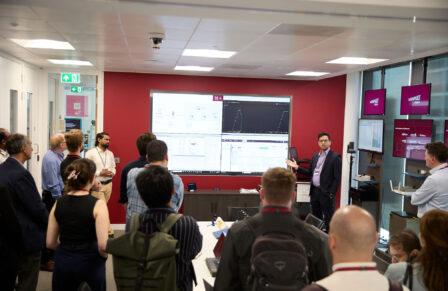
An important part of our work at UKTIN is supporting the use and deployment of advanced connectivity solutions, and exploring how to surmount the barriers to their adoption.
We focus on four industrial sectors:
- Agriculture
- Health and Social Care
- Manufacturing
- Transport & Logistics
As well as Regional (place based) issues – particularly the role of local authorities programme and their role in leading place based digital transformation (this includes the 10 DSIT funded 5G Innovation Region projects).
We are indebted to the five voluntary Adoption Working Groups who give up their time to enable this work. There are 82 members involved and we could not coordinate this work, particularly the creation of practical case studies and examples of best practice, without their input.
Insights
In July 2024, UKTIN produced an internal report which provided insights into adoption of advanced wireless connectivity in these key sectors, based on feedback from the working group members.
The report considered the challenges in each sector, barriers to adoption, some successful examples of adoption, market opportunities and the perceived effect of government policy.
Each sector faces a unique set of barriers. Some of these are fundamental challenges, such as weather and climate uncertainty in agriculture, or energy cost pressures impacting the financial stability of manufacturers. Local authorities are facing such a range of challenges, including huge budgetary pressures, regeneration, economic development, social care, and leading on net zero, all of which can lead to policy paralysis.
- Some of these have direct implications for the adoption of services, such as poor wireless connectivity in rural areas (impacting both agriculture and health social care particularly), high power requirements of the agricultural sector, legacy systems and fragmented funding streams in health and social care, a need for a blend of indoor and outdoor coverage in manufacturing, and the need to tackle connectivity on trains.
The resounding feedback was that advanced wireless connectivity can be used to help solve many of the fundamental challenges these sectors face, but adoption isn’t happening at scale yet. There are multiple reasons for this, but the main barriers reported by the working groups were:
- High Cost to Deploy Networks: The initial setup costs for networks and sensors can be significant, making it difficult for many organisations to invest in advanced wireless technology without stacking a number of use cases together.
- Limited Network Coverage and Reliability: Many areas, especially rural locations, suffer from poor network coverage and unreliable connectivity, which hampers the adoption of technologies powered by advanced wireless solutions
- Unproven Return on Investment (ROI): There is a lack of evidence or clear business cases demonstrating the ROI of adopting advanced wireless technology, making it challenging for organisations to justify the investment
- Lack of Digital Skills: A shortage of digital skills, particularly in public sector domains, affects the ability to implement and manage advanced wireless technologies
- Device Compatibility: Compatibility issues between different devices and technologies pose a significant barrier to adoption
- Spectrum Licensing Process: The process of applying for spectrum licenses is perceived to be complex and time-consuming, requiring specialised knowledge and resources
- Cultural Resistance to Change: Especially within public sector domains such as health and social care, which hinders the deployment and use of new technologies
- Lack of Scale-Up Funding: Limited availability of funding for scaling projects beyond the initial pilot phase, prevents widespread adoption
- Market Perception Challenges: Including a lack of awareness of the benefits of advanced wireless technology and scepticism about its advantages over existing solutions
The report suggests the continuing need for targeted interventions and support to overcome these challenges and facilitate wider adoption.
It was reported that many of the previous government funded projects were excellent in terms of outcomes, but often stalled when the funding finishes, creating an adoption gap after the innovator and early adopter phases. There was therefore positive feedback regarding the aims of the DSIT 5GIR programme, and it will be crucial that the key lessons and sustainability plans are widely shared - UKTIN is already working to do this. More interventions may be needed to scale-up beyond the 5GIR programme into adjacent clusters and then into the SME ecosystem.
To address the adoption gap, it was recommended that the UK develops an adoption vision and strategy that focuses on the strengths of the country. Four key priorities that should be considered to deliver this vision:
- Prove and evidence breakthrough solutions (this has been started with 5GIR)
- Lead scaling up in adjacent clusters (within the market sectors)
- Lead development of next use cases and productisation with SMEs
- Put in place the strategic enablers for lift-off to include spectrum, skills, finance, tools and transformational support
There are also some smaller initiatives that could be put in place to stimulate adoption in the short term, such as:
- accurate and freely available coverage mapping across the UK
- a supplier directory linking buyers and sellers in each specific sector
- ecosystem stimulation events that aim to get all stakeholders talking to each other about key challenges to adoption including the commercial routes
Alongside these cross-sector recommendations, the Regional Working Group identified a series of key recommendations for government intervention to provide necessary financial support and policy direction to Local Authorities for digitisation of public services supported by wireless connectivity. These recommendations include:
- Establish a ring-fenced, multi-year digital transformation fund for LAs, aligned to clear milestones and outcomes;
- Develop a national digital transformation policy for local authorities, with cross-government alignment to ensure consistency. The policy should mandate specific `digital by design’ requirements into all future procurements and interventions, including any roll-over or resurrected legacy plans;
- Support a national digital skills development programme to address the expertise gap in local government;
- Provide targeted revenue funding for procurement, business and operational change management resources for LAs. These resources to sit regionally so they can support multiple activities across multiple authorities;
- Incentivise regional collaboration and shared digital platforms and resources to reduce disparities and improve efficiency;
- Convene a cross-government working group consisting of all responsible government departments supporting policy for public service provisions (eg. DfT, DSIT, MHCLG, NHS, Home Office etc) to lead consultations with senior local government leaders on digital transformation.
Next Steps
It’s clear there is more work to do. In support of this, UKTIN is committed to producing a second and deeper market engagement report in early 2025.
This process starts now.
We want to extend the evidence base, and will be consulting widely throughout November to obtain feedback not only from the UKTIN ecosystem but also from a wide variety of stakeholders and organisations.
We would welcome all viewpoints and insights. To have your say, please complete our survey - it’s extremely short and shouldn’t take more than five minutes.
It is with regret that we have had to postpone this week’s planned adoption-focused event due to tube strikes, which impacted us being able to deliver the quality event we had planned. However, we are delighted to announce we have now rescheduled the event for 28 January. If you were registered for this event, please look out for a direct invitation to register for the new date.









